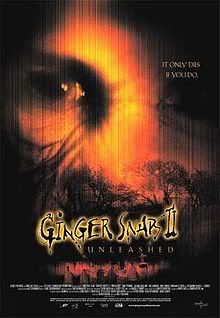Rick Rosenthal’s 2002 Halloween: Resurrection had me turning to the Sunday Mail crossword within 15 minutes. The violence was realistic – the reason Vincent Price left Hammer Films – and held up too accurate a mirror to society for an example of the genre that has acquired the epithet “popcorn gore”.
 John Fawcett’s 2002 Ginger Snaps 2: Unleashed was a dog of a different colour. The original film, Ginger, had been criticised for overegging lycanthropy as a metaphor for (female) puberty, but by the sequel it had found its paws.
John Fawcett’s 2002 Ginger Snaps 2: Unleashed was a dog of a different colour. The original film, Ginger, had been criticised for overegging lycanthropy as a metaphor for (female) puberty, but by the sequel it had found its paws.We rarely saw the werewolf, but that seemed the point. The beastie was a prop on which to hang elements of a story in a feature-length meditation on the disparate ways we exploit, decieve and hurt each other underneath a civilised façade. The evils were all the more frightening because, contrary to Michael Myers (or Damien in The Omen, Dracula in the original, etc) they were subject to no aim, no unifying persona and had no motive other than human nature. Ginger Snaps 2entirely deserves a place in the hallowed company of films like King Kong and Nightbreed, where humanity is the ultimate monster.
But what of the popcorn gore film-makers? We could put them to work chronicling the real, quotidian horrors that comprise the picture in the attic of the gingerbread house many politicians insist we inhabit. For a start, I would recommend they tackle the almost unspeakable murder of Charlene Downes in Blackpool. That would tick all the boxes: violent, sick, and featuring monsters to make your blood run cold.
Gerry Dorrian
300 words
No comments:
Post a Comment